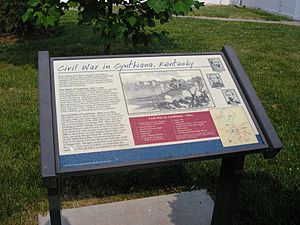Battle of Cynthiana facts for kids
Quick facts for kids Second Battle of Cynthiana |
|||||||
|---|---|---|---|---|---|---|---|
| Part of the American Civil War | |||||||
 Interpretive panel in Cynthiana |
|||||||
|
|||||||
| Belligerents | |||||||
| Commanders and leaders | |||||||
| Conrad Garis Edward H. Hobson Stephen Gano Burbridge |
John H. Morgan H. L. Giltner D. Howard Smith Robert M. Martin |
||||||
| Units involved | |||||||
| 168th Ohio Infantry 171st Ohio Infantry Harrison County Home Guards 7th Ohio Cavalry 12th Ohio Cavalry 9th Michigan Cavalry 11th Michigan Cavalry 16th Kentucky Cavalry 30th Kentucky Infantry 39th Kentucky Infantry 37th Kentucky Infantry 40th Kentucky Infantry 47th Kentucky Infantry 52nd Kentucky Infantry Battery "C" Kentucky Light Artillery |
1st Kentucky Special Cavalry Battalion 2nd Kentucky Special Cavalry Battalion 3rd Kentucky Special Cavalry Battalion 4th Kentucky Cavalry 10th Kentucky Cavalry Battalion 1st Kentucky Mounted Rifles Battalion 2nd Kentucky Mounted Rifles Battalion 10th Kentucky Mounted Rifles Battalion 6th Confederate Battalion |
||||||
| Strength | |||||||
| 2400 | 1,200 | ||||||
| Casualties and losses | |||||||
| 1,092 | 1,000 | ||||||
The Second Battle of Cynthiana was a series of three fights during the American Civil War. These battles happened on June 11 and 12, 1864, in and around Cynthiana, Kentucky. This event was part of a daring raid into Kentucky led by Confederate General John H. Morgan.
The battle ended with a big win for the Union forces. It also marked the end of Morgan's last raid into Kentucky. Morgan's troops had actually captured Cynthiana before, in 1862, during the First Battle of Cynthiana.
Contents
What Happened on June 11?
Morgan's Attack on Cynthiana
Early on June 11, 1864, General John H. Morgan and about 1,200 cavalry soldiers arrived near Cynthiana. The town was defended by a smaller Union force. This force had about 300 men, led by Colonel Conrad Garis. It included soldiers from the 168th Ohio Infantry and some local home guard troops.
Morgan split his soldiers into two groups. They attacked the town from the south and east. They first attacked a covered bridge, pushing Colonel Garis's men back. The Union soldiers retreated towards the Kentucky Central Railroad depot. They also moved north along the railroad to the Rankin House, which they used as a strong defensive spot.
Since Morgan's troops did not have cannons, they could not easily force the Union soldiers out. So, the Confederates set fire to parts of the town. This destroyed 37 buildings and sadly killed some Union soldiers.
The Fight at Keller's Bridge
While fighting was happening in Cynthiana, another Union force arrived. This group had about 500 men from the 171st Ohio Infantry. They were led by Brigadier General Edward H. Hobson. They arrived by train about a mile north of Cynthiana, near Keller's Bridge. Morgan's men had burned this bridge a few days earlier.
General Hobson's troops fought parts of Morgan's force for about six hours. Eventually, Morgan managed to trap these new Union soldiers near the Licking River. By the end of the day, Morgan had about 1,300 Union prisoners. They camped with him overnight. The next day, the 171st Ohio Infantry soldiers were released. This fight, known as the Battle of Keller's Bridge, was Morgan's last victory.
What Happened on June 12?
The Union Counterattack
General Morgan had very little ammunition left. But he made a risky choice to stay and fight a larger Union force that he expected to arrive. Brigadier General Stephen G. Burbridge led this larger Union force. He had 2,400 men, including soldiers from Ohio, Kentucky, and Michigan. They were mounted infantry and cavalry, and they also had some cannons.
General Burbridge's forces attacked Morgan's troops at dawn on June 12. This battle took place on the hills east of Cynthiana. The Union soldiers pushed the Confederates back. Morgan's men were forced to flee into Cynthiana. Many were captured or killed there. General Morgan and many of his officers managed to escape.
Counting the Losses
The Union forces had about 1,092 soldiers killed, wounded, or captured in these battles. Morgan's forces are thought to have lost about 1,000 men, though exact numbers are not known.
The Second Battle of Cynthiana showed that the Union Army was growing stronger. They had more soldiers and could move them around faster. This meant that Confederate cavalry and guerrilla fighters could no longer raid areas without facing strong resistance.
Images for kids


